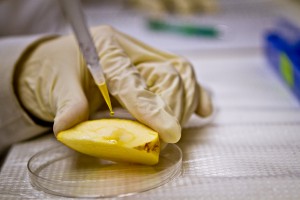 What’s a nanoparticle? As the name implies, a nanoparticle is extremely small. “A nanoparticle (or nanopowder or nanocluster or nanocrystal) is a microscopic particle with at least one dimension less than 100 nm,” according to Science Daily. From sunscreen to socks to children’s scissors, nanoparticles are appear in everyday objects.
What’s a nanoparticle? As the name implies, a nanoparticle is extremely small. “A nanoparticle (or nanopowder or nanocluster or nanocrystal) is a microscopic particle with at least one dimension less than 100 nm,” according to Science Daily. From sunscreen to socks to children’s scissors, nanoparticles are appear in everyday objects.
The University of Missouri’s News Bureau has just released some breaking news:
Toxic silver nanoparticles may be entering our food supply!
Over the last few years, the use of nanomaterials for water treatment, food packaging, pesticides, cosmetics and other industries has increased. For example, farmers have used silver nanoparticles as a pesticide because of their capability to suppress the growth of harmful organisms. However, a growing concern is that these particles could pose a potential health risk to humans and the environment. In a new study, researchers at the University of Missouri have developed a reliable method for detecting silver nanoparticles in fresh produce and other food products.
“More than 1,000 products on the market are nanotechnology-based products,” said Mengshi Lin, associate professor of food science in the MU College of Agriculture, Food and Natural Resources. “This is a concern because we do not know the toxicity of the nanoparticles. Our goal is to detect, identify and quantify these nanoparticles in food and food products and study their toxicity as soon as possible.”
Lin and his colleagues, including MU scientists Azlin Mustapha and Bongkosh Vardhanabhuti, studied the residue and penetration of silver nanoparticles on pear skin. First, the scientists immersed the pears in a silver nanoparticle solution similar to pesticide application. The pears were then washed and rinsed repeatedly. Results showed that four days after the treatment and rinsing, silver nanoparticles were still attached to the skin, and the smaller particles were able to penetrate the skin and reach the pear pulp.
“The penetration of silver nanoparticles is dangerous to consumers because they have the ability to relocate in the human body after digestion,” Lin said. “Therefore, smaller nanoparticles may be more harmful to consumers than larger counterparts.”
When ingested, nanoparticles pass into the blood and lymph system, circulate through the body and reach potentially sensitive sites such as the spleen, brain, liver and heart.
The growing trend to use other types of nanoparticles has revolutionized the food industry by enhancing flavors, improving supplement delivery, keeping food fresh longer and brightening the colors of food. However, researchers worry that the use of silver nanoparticles could harm the human body.
Silver has long been used for its antimicrobial properties, but its widespread use in nano form could breed bacterial resistance, ruining its use where it is needed most — in hospitals — and speeding the development of super bugs. Close to 100,000 Americans die each year because of untreatable infections — more than two times the annual road toll.
This is really scary! The Government should address this asap! This could lead to more serious health problems if taken for granted.